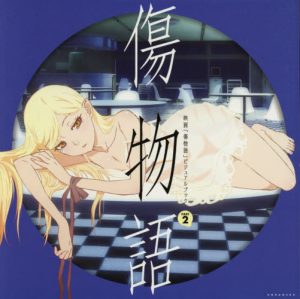Kizumonogatari is the prequel to Monogatari and the long awaited movie series by Shaft. Fans of the series are blessed with an amazing spectacle, the film’s cinematography is an apt juxtaposition of the original’s visuals and characters.
For those unaware, Monogatari borrows visual elements from the French New Wave, a film movement that started in France during the late 1950s to the 1960s. To assuage the financial limitations of films in a post WWII France, artists of this period experimented with directing, giving rise to techniques such as the jump cut, characters stepping out of their role to address the audience, filming dialogue using objects to represent character, and more.
To push the idea of a prequel, a different style is used for this film trilogy. Film noir, a period from the 1940s to the late 1950s, became the guiding principle of Kizumonogatari. To carry the idea of a “period before Monogatari,” the ingenious decision of using film noir creates a visual themes that emboldens the story and characters.This article will be a two-part series. The first article will explain film noir and talk about how the color scheme and lighting is similar.
A Little Context on Film Noir
To better understand film noir, we should first roughly define it. Film noir, however, is difficult to define--critics and scholars of film have an ongoing debate if film noir can even be considered a genre.
Visually, film noir emphasizes dramatic shadow, a focus on light, and a strong contrast between black and white. However, to define a film solely on its visuals comes into problems. For example, even though the film Casablanca (1942), shares some characteristics, it is not a film noir. There are even modern day examples of film noir that are not black/white, making it confusing for new viewers.
The murkiness of this problem arises from how other film genres are defined. Some can be defined by their location (Westerns), tone (Comedy), or the activities that happen within the movie (Action). Film noir, however, is defined more by its themes, and themes aren’t exclusive to a genre.
To begin, film noir uses its themes to address concerns of its time (1940s - 1950s). During the aftermath of World War II, the question of one’s role in society and the belief that “with time comes progress” disintegrated. This pessimism is deeply imbedded in noir’s most common setting: the crime-filled city.
The city provided the many locations where both lighting and shadows could be controlled. It also is where common conventions of justice and morality are twisted, inviting both the corrupt cop and likeable villain. In cities at the center of World War II, this was a recognizable reality.
For America, when their soldiers returned from the war, the economic landscape of America had changed. Prior to the war, the common family would have a house wife and a husband who would be the main breadwinner of the family. To provide the military supplies needed, women were motivated to enter the workforce, providing much of the economic requirements of the war.
Given the horrors of war, the uncertain future, and the changing role of men, uncertainty of the masculine identity became topics noir would address. This is shown through how little control noir protagonist’s have over their situation.
Does a protagonist want to “save the situation?” Noir protagonists make situations worse (China Town), are unwanted (The Third man), or even killed trying to save “damsels in distress” (Sunset Boulevard) who are actually femme fatales, women who lure men into dangerous situations, eventually pushing them to their downfall.
Moral ambiguity, uncertainty of the future, the disintegration of one’s role, the control one has over their fate are thematic concepts within film noir. The world has changed, and the old ideals are dead--the hero cannot save anyone.
Now You See It: Kizumonogatari’s Color and Lighting
Let’s begin with color. Much of film noir uses a high contrast of light and shadows. While noir movies of the 1940s and 1950s were in black and white, contemporary film noirs utilize color.
To capture a high contrast of light and dark, Kizumonogatari uses red and white with pink. These colors are, respectively, the black, white, and gray of noir. To further emphasize lighting and contrast, adaptation decisions were made. For example, the meeting place of Heart-Under-Blade (the vampire) and Araragi was originally a dark alleyway. However, to emphasize the contrast again of red and white, the scene of their meeting was moved to a bright subway, lit by a stark white of the ceiling and given different lighting and shadows by passing trains.
The reason for this change in location is three-fold. First is to emphasize the color scheme of the movie. Blood on white is hard to ignore after all. The second is to make it deliberately obvious that if Araragi ignores the vampire, his excuse cannot be “I did not see her.” Lastly, the moral dilemma is emphasized by making it evident that she will die--ignoring her means you have decided to let her die. No one survives with that much blood loss.
After giving up his blood to Heart-Under-Blade, the world becomes a different place. As a vampire, he can no longer enter normal society. The opening scene of the first movie serves to prove that. Daring to walk outside, Araragi is first shielded from the light from overhead clouds, but as the sun emerges, his body lights on fire, and he falls from the rooftops to the ground. The camera cuts to the Japanese flag, a reminder that although noir takes place in cities, it can also take place in the land of the rising sun.
Just as noir uses lighting to emphasize its themes, Kizumonogatari also has creative uses of light and shadow. The aforementioned subway scene is an amazing example, however the use of literal spotlights for Heart-Under-Blade and Araragi’s surreal/ideal “dream sequence” (movie 3), the general atmosphere of the city and car lights, the use of flashlight as a stand-in for stage lights of a play (movie 3), and the opening scene (movie 1) are further examples of careful attention to lighting. Lighting in Kizumonogatari segments the ideal and real, divides the underworld/spiritual and real/forbidden world, and influences actions of its characters.
Final Thoughts

Kizumonogatari is a visual masterpiece. There is so much to say about its creative decisions that I had to divide up the topics into two articles. While most of this article was spent discussing film noir as a genre/style, I believe that understanding that will make my second article more approachable and concise.
I was really nervous explaining how film noir addresses concerns of its time--this is about as best as I can do. Scholars far more talented than I have debated on how much postwar or wartime influenced the visual style and themes of noir films. If you’re interested in getting further context, I recommend Sheri Chinen Biesen’s book, Blackout: World War II and the Origins of Film Noir. It presents an argument that film noir arose because of specific elements during World War II and not after.
For now, if this article has intrigued you or helped you appreciate Kizumonogatari more, I’m glad. I hope you look forward to the second article!
Recommended Post


